History
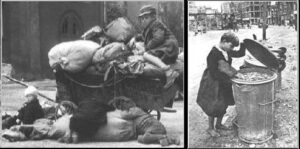 Wars leave unfortunate consequences, one of the biggest being orphaned children. World War II is no exception to that rule. After the surrender of Germany, the nation was basically split into four sections…the American Zone, the Soviet Zone, the British Zone, and the French Zone. It was all part of the denazification process. The term denazification refers to the removal of the physical symbols of the Nazi regime. In 1957 the West German government re-issued World War II Iron Cross medals, among other decorations, without the swastika in the center. That was just one of the ways that the Nazi regime was removed from Germany.
Wars leave unfortunate consequences, one of the biggest being orphaned children. World War II is no exception to that rule. After the surrender of Germany, the nation was basically split into four sections…the American Zone, the Soviet Zone, the British Zone, and the French Zone. It was all part of the denazification process. The term denazification refers to the removal of the physical symbols of the Nazi regime. In 1957 the West German government re-issued World War II Iron Cross medals, among other decorations, without the swastika in the center. That was just one of the ways that the Nazi regime was removed from Germany.
Another way was the Denazified School System and the denazification of the rest of the German government…which was then reassembled without the Nazi symbolism. With the school system effectively out of commission, the children of Berlin had very little or even no structure in their lives at all. These were children whose lives had been shredded by the war, many of whom had been orphaned by the conflict or had lost at least one parent. That lead to an overall lack of adult supervisors. Children, and especially teens and preteens, roamed the streets in packs. The situation was especially difficult for the children who had lost both parents. There weren’t any real orphanages either, and so these children formed their own “families” on the streets…like street gangs. These children were known as German “wolf children” also known as “Wolfskinder,” but the reality was that they were simply the forgotten orphans of World War II.
The schools eventually reopened, but they were often in half-ruined facilities, that were underfunded and understaffed, with some schools reporting student-to-faculty ratios of 89 to 1. That kind of a classroom ratio is far too big to be able to effectively teach the students. And the re-opened schools didn’t really address the issue of these orphaned “wolf children” who were often in hiding whenever authorities were around. These children were most likely afraid of authority, because it was the authorities who got their parents killed in the first place. Many of these children were forced to flee what was then East Prussia to Lithuania at the end of World War II. They felt like the German government had failed them. These children survived hunger, cold, and the loss of their identity, and the German government had long overlooked them, so why would they trust the government now.
No one really knows just how many “wolf children” there were. That number can only be estimated. Some say there were up to 25,000 of them roaming the woods and swamps of East Prussia and Lithuania after 1945. Russians were actually forbidden from taking in these “fascist children.” These children were actually told to go to Lithuania and given the promise that there would be food there. When they arrived, they couldn’t speak the language and they had no papers, so they had no identity…no one could even know their names. Those who were taken in often had every shred of memorabilia from their past stripped from them and tossed in the trash. That was the last part of who they really were. It was the price they would pay for food, safety, and security; and it was a failure of the German government, and the four nations who were in charge of reorganizing Germany. I suppose some would disagree with me on that note, but the reality is plain to see. If these children came across kind locals, the “Vokietukai” or little Germans, in Lithuanian, as they were known, were helped with buckets of soup in front of the doors, giving the children a little nourishment. If the residents were not so kind, they would set their dogs on the children.
While the “Vokietukai” had many struggles in Lithuania, life was still better than the fate that awaited the 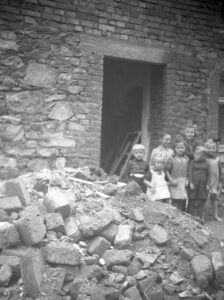
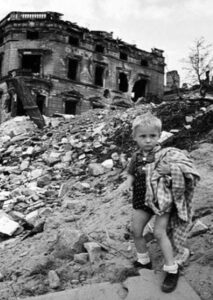 children who were too weak to make it to the Baltic states. There were thousands of these children, and they were sent to Soviet homes run by the military administration. That was the fate of approximately 4,700 German children in 1947, according to historian Ruth Leiserowitz, who has researched the fates of wolf children. Later that year, many of them were sent to the Soviet occupation zone. That zone later became the German Democratic Republic (GDR). Those poor children traveled in freight trains without any straw to sleep on…similar the Holocaust deportation years. These children were young…between 2 and 16 years of age. They arrived in East Germany after four days and four nights…really more dead than alive. There, they were put in orphanages or adopted by avid Communists. They never really escaped Communism…and that is the saddest part of all.
children who were too weak to make it to the Baltic states. There were thousands of these children, and they were sent to Soviet homes run by the military administration. That was the fate of approximately 4,700 German children in 1947, according to historian Ruth Leiserowitz, who has researched the fates of wolf children. Later that year, many of them were sent to the Soviet occupation zone. That zone later became the German Democratic Republic (GDR). Those poor children traveled in freight trains without any straw to sleep on…similar the Holocaust deportation years. These children were young…between 2 and 16 years of age. They arrived in East Germany after four days and four nights…really more dead than alive. There, they were put in orphanages or adopted by avid Communists. They never really escaped Communism…and that is the saddest part of all.
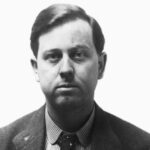
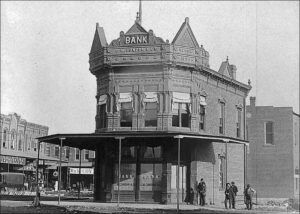 While on a trip to Tulsa, Oklahoma with my sisters, Caryl Reed and Alena Stevens, we happened to drive through the little town of Coffeyville, Kansas. We noticed a sign that said Dalton Graves. I immediate thought of the Dalton Gang and looked it up on my phone. Sure enough, Coffeyville is the site of a number of graves of the Dalton Gang. I find it strange that the gang would choose Coffeyville as the town to rob two banks at the same time, because it was in Coffeyville, that their brother Frank was buried. Frank had been a Deputy US Marshall based out of Fort Smith, Arkansas. On November 27, 1887, while involved in a gunfight with an outlaw gang near the Arkansas River, Frank Dalton was shot and killed by the outlaw, Will Towerly. It’s just odd that they would disrespect Frank’s memory in that way.
While on a trip to Tulsa, Oklahoma with my sisters, Caryl Reed and Alena Stevens, we happened to drive through the little town of Coffeyville, Kansas. We noticed a sign that said Dalton Graves. I immediate thought of the Dalton Gang and looked it up on my phone. Sure enough, Coffeyville is the site of a number of graves of the Dalton Gang. I find it strange that the gang would choose Coffeyville as the town to rob two banks at the same time, because it was in Coffeyville, that their brother Frank was buried. Frank had been a Deputy US Marshall based out of Fort Smith, Arkansas. On November 27, 1887, while involved in a gunfight with an outlaw gang near the Arkansas River, Frank Dalton was shot and killed by the outlaw, Will Towerly. It’s just odd that they would disrespect Frank’s memory in that way.
Nevertheless, it was in Coffeyville, Kansas that the Dalton Gang would make what was for all of them, except Emmett Dalton, a fatal decision. The men rode into town in the early morning hours of October 5, 1892. Their plan was to tie their horses to the hitching posts in front of the bank, however, the town had wisely removed them, meaning that one member would have to hold the horses, or they would have to tie the horses to a hitching post in another part of town. Choosing the latter, the gang tied their horses in what became known as “Death Alley” and headed for the banks.
Unfortunately for the gang, one of the townspeople recognized one of the gang members as he made his way to the bank. Immediately reporting this to the local law and the rest of the town, the people were ready for the gang when they emerged from the banks. A running gun battle ensued, and in the process, four members of the Dalton gang lost their lives. Killed were Bob Dalton, Grat Dalton, Bill Power, and Dick Broadwell. Emmett Dalton, the only surviving member of the gang was severely wounded and was not expected to live. Nevertheless, he recovered and served 14 years in jail before being pardoned.
Bob Dalton, Grat Dalton, and Bill Powers were buried in the same plot, in the Elmwood Cemetery, and for years the only marker for their grave was the metal hitching post to which they tied their horses on that fateful day. When Emmett Dalton was released, he purchased a grave marker for the three men, but the hitching post remains to this day. Also buried in Elmwood Cemetery are the four town defenders who lost their lives in that gunfight. Those lost were Lucius Baldwin, Charles Brown, Marshal CT Connelly, and George Cubine. Needless to 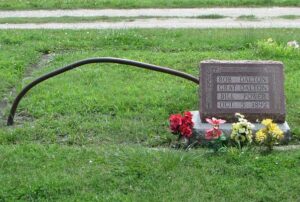
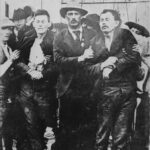 say, their graves received respectful stones from the very beginning, in order to rightly honor these brave men. Emmett Dalton moved to Southern California in 1907. He married Julia Johnson the following year, who survived him. During his California years, he capitalized on his notoriety…writing two books and doing some acting in Hollywood. Later, he sold real estate, as Southern California was developing rapidly with migrants from across the country. He died in 1937 at the age of sixty-six.
say, their graves received respectful stones from the very beginning, in order to rightly honor these brave men. Emmett Dalton moved to Southern California in 1907. He married Julia Johnson the following year, who survived him. During his California years, he capitalized on his notoriety…writing two books and doing some acting in Hollywood. Later, he sold real estate, as Southern California was developing rapidly with migrants from across the country. He died in 1937 at the age of sixty-six.
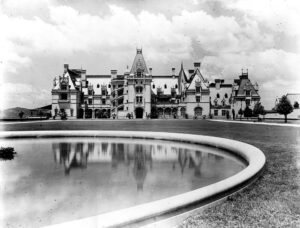
 During what became known as the Gilded Age in United States history, extending roughly from 1870 to 1900, the economy grew so rapidly that the wages of Americans, especially in the Northern and Western United States actually surpassed the wages in Europe, especially for skilled workers. Still, increased industrialization demanded an increased unskilled labor force too, so the there was an influx of millions of European immigrants looking for a better life, to fill the need for workers. Basically, the Gilded years were years of overwhelming extravagance.
During what became known as the Gilded Age in United States history, extending roughly from 1870 to 1900, the economy grew so rapidly that the wages of Americans, especially in the Northern and Western United States actually surpassed the wages in Europe, especially for skilled workers. Still, increased industrialization demanded an increased unskilled labor force too, so the there was an influx of millions of European immigrants looking for a better life, to fill the need for workers. Basically, the Gilded years were years of overwhelming extravagance.
While many of the estates of the Gilded Age were in the Eastern United States, not all the great estates were in places like New York City or Newport, Rhode Island. Some of the very wealthy apparently didn’t really like the Northern winter climates, so they chose to build their estates in areas of the South. One of the greatest of these southern estates was the Biltmore Estate near Asheville, North Carolina, The estate was built by George Washington Vanderbilt II between 1889 and 1896, and it is enormous!! The estate covers nearly 11 miles. Of course, the real difference between what we would consider a mansion, and the Gilded Era estates is the fact that the grounds are as extravagant as the homes. The main house of the Biltmore Estate has nearly 200,000 square feet!! Most of us consider a nice sized house to be 2,000 to 3,000 square feet, so 200,000 square feet, for me at least, is beyond what I can even imagine in a house. The construction was a huge undertaking, that literally took building an entire working village near the site to house the workers, manufacturers, and supplies. A three-mile railroad spur was even built just to transport building supplies to the construction site. More than 1,000 workers were hired to build the huge house.
The Biltmore remains in the ownership of the Vanderbilt family, with at least one member of the family living there until 1956, at which point it was operated as a historic museum. It is the largest privately owned home in the United States. To help with the high cost of modern maintenance and expenses, the house and grounds are 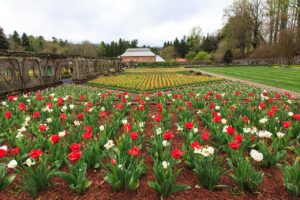
 open to the public, for a price, and a number of ticketed events are held on the site throughout the year. At the request of the City of Asheville, which hoped to revitalize the area with tourism, and in an attempt to bolster the estate’s finances during the Great Depression, Cornelia and her husband opened Biltmore to the public in March 1930 at the request of the City of Asheville.
open to the public, for a price, and a number of ticketed events are held on the site throughout the year. At the request of the City of Asheville, which hoped to revitalize the area with tourism, and in an attempt to bolster the estate’s finances during the Great Depression, Cornelia and her husband opened Biltmore to the public in March 1930 at the request of the City of Asheville.
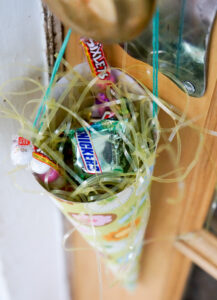
 May Day is an almost forgotten day of the “special days” on the calendar. When I was a kid, our mother, Collene Spencer helped us make “May Baskets” and fill them with candy. Then we would take them to the neighbors’ homes and hang them on the doorknobs. We would then knock on the door and go hide. The homeowner then had to try to find us…or they could just shout out their “thank you” and enjoy the candy. No matter what they decided to do, we always had a great time giving May Baskets, and I think it taught us to be givers.
May Day is an almost forgotten day of the “special days” on the calendar. When I was a kid, our mother, Collene Spencer helped us make “May Baskets” and fill them with candy. Then we would take them to the neighbors’ homes and hang them on the doorknobs. We would then knock on the door and go hide. The homeowner then had to try to find us…or they could just shout out their “thank you” and enjoy the candy. No matter what they decided to do, we always had a great time giving May Baskets, and I think it taught us to be givers.
There are a number of traditions that were carried out in the early years of May Day, but have since faded away. Things like the May Pole dance and fire cleansing (I’m not even sure what that is). There might be places 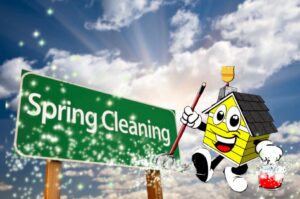 where they still celebrate in this way, and some towns actually have a permanent May Pole. Some other traditions like the May Baskets and spring cleaning have stuck it out for the long haul. I’ll bet you didn’t even know that spring cleaning actually started as a May Day tradition, and yet millions of people do some time of spring cleaning, yard preparation, and even redecorating or remodeling beginning on May Day.
where they still celebrate in this way, and some towns actually have a permanent May Pole. Some other traditions like the May Baskets and spring cleaning have stuck it out for the long haul. I’ll bet you didn’t even know that spring cleaning actually started as a May Day tradition, and yet millions of people do some time of spring cleaning, yard preparation, and even redecorating or remodeling beginning on May Day.
For me, these days, May Day doesn’t involve May Baskets. That is a tradition that went by the wayside with my adulthood. I think my mom would have done that for all of her life, if she could find willing co-conspirators, and that makes me a little sad, because Mom never really asked much of anyone. Nevertheless, she did love her 
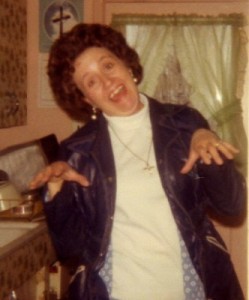 traditions, and it must have been a little sad for her to see May Baskets go by the wayside. For me, May Day really doesn’t mean anything much, except that Spring is finally…really here. The days are longer and warmer. I can get outside and walk on my trail, especially in the early mornings, which have been far too cold prior to this, and still might be a bit cold some mornings. It always seems like the year shifts into high gear on May Day, because while I don’t mind Fall, I don’t look forward to the coming Winter. I am more of a three-season girl, who would love to just skip Winter completely, but I live in the wrong state for that so…anyway, happy May Day everyone. May your celebration…whatever that is, be sweet and special.
traditions, and it must have been a little sad for her to see May Baskets go by the wayside. For me, May Day really doesn’t mean anything much, except that Spring is finally…really here. The days are longer and warmer. I can get outside and walk on my trail, especially in the early mornings, which have been far too cold prior to this, and still might be a bit cold some mornings. It always seems like the year shifts into high gear on May Day, because while I don’t mind Fall, I don’t look forward to the coming Winter. I am more of a three-season girl, who would love to just skip Winter completely, but I live in the wrong state for that so…anyway, happy May Day everyone. May your celebration…whatever that is, be sweet and special.

 My favorite part of war history, if a person should have a favorite part, would be World War II. It was the war my dad, Allen Spencer fought in, and maybe that is why I am so interested in it and in the B-17 Flying Fortress, from which he fought and returned home. The men and women who fought in World War II are called the Greatest Generation, and maybe because my dad was a part of that, I am partial to that part of history. I find it a bit strange that while the Vietnam Memorial Fund, Inc (VVMF) was incorporated as a non-profit organization to establish a memorial to veterans of the Vietnam War, on April 27, 1979, four years after the Fall of Saigon, but the World War II Memorial didn’t open until April 29, 2004, in Washington DC. Of course, I think it was cool that it opened on my birthday, but it really was a long overdue recognition for the 16 million US men and women who served in the war. The memorial is located on 7.4 acres on the former site of the Rainbow Pool at the National Mall between the Washington Monument and the Lincoln Memorial. The Capitol dome can be seen to the east, and Arlington Cemetery is just across the Potomac River to the west. It really is a beautiful setting and shows the proper honor to these men and women of the Greatest Generation.
My favorite part of war history, if a person should have a favorite part, would be World War II. It was the war my dad, Allen Spencer fought in, and maybe that is why I am so interested in it and in the B-17 Flying Fortress, from which he fought and returned home. The men and women who fought in World War II are called the Greatest Generation, and maybe because my dad was a part of that, I am partial to that part of history. I find it a bit strange that while the Vietnam Memorial Fund, Inc (VVMF) was incorporated as a non-profit organization to establish a memorial to veterans of the Vietnam War, on April 27, 1979, four years after the Fall of Saigon, but the World War II Memorial didn’t open until April 29, 2004, in Washington DC. Of course, I think it was cool that it opened on my birthday, but it really was a long overdue recognition for the 16 million US men and women who served in the war. The memorial is located on 7.4 acres on the former site of the Rainbow Pool at the National Mall between the Washington Monument and the Lincoln Memorial. The Capitol dome can be seen to the east, and Arlington Cemetery is just across the Potomac River to the west. It really is a beautiful setting and shows the proper honor to these men and women of the Greatest Generation.
The 16 million men and women who served in the armed forces of the US are honored at the World War II Memorial, as well as the more than 400,000 who died, and all who supported the war effort from home. The memorial was built using granite and bronze. It features fountains between arches to symbolize hostilities in Europe and the Far East. The arches are bordered by semicircles of pillars, one each for the states, territories, and the District of Columbia. Beyond the pool is a curved wall of 4,000 gold stars, one for every 100 Americans killed in the war. It also features an Announcement Stone that states that the memorial is to honor those 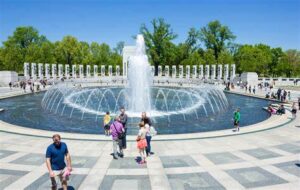 “Americans who took up the struggle during the Second World War and made the sacrifices to perpetuate the gift our forefathers entrusted to us: A nation conceived in liberty and justice.”
“Americans who took up the struggle during the Second World War and made the sacrifices to perpetuate the gift our forefathers entrusted to us: A nation conceived in liberty and justice.”
The project was funded with more than $164 million dollars in private donations, and an additional $16 million donated by the federal government. Former Kansas Senator Bob Dole, who was severely wounded in the war, and actor Tom Hanks were among its most vocal supporters. The really sad part is that only a fraction of the 16 million Americans who actually served in the would ever see it…my dad included. While he was alive in 2004, that was not a trip he got to take before his passing in 2007. Four million World War II veterans were still living at the time the memorial was finally opened, but more than 1,100 dying every day, according to government records. I find that to be so sad.
Roger Durbin of Berkey, Ohio, who served under General George S Patton, inspired the memorial. Durbin was at a fish fry near Toledo in February 1987, when he asked US Representative Marcy Kaptur why there was no memorial on the Mall to honor World War II veterans. It was a question that should have been asked and answered long ago. Nevertheless, Kaptur, an Ohio Democrat, introduced legislation to build one, starting a process that would stumble along through 17 years of legislative, legal, and artistic entanglements. Durbin died of pancreatic cancer in 2000, without ever actually seeing his hard work come to fruition. While he didn’t live to see his project come to life, I and so many other children of World War II veterans and lost loved ones, will be forever thankful to him for finally making sure our loved ones were properly honored. The monument was formally dedicated May 29, 2004, by US President George W Bush, but I am pleased that it actually opened on 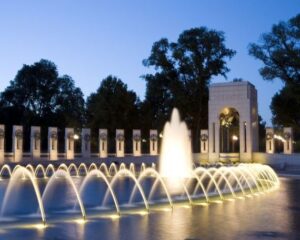
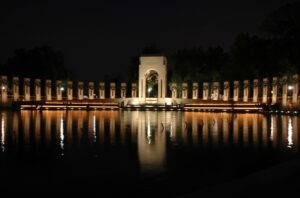 my birthday in 2004. My birthday, because it was just two days after my dad’s birthday, has always been a special time that we shared. Of course, I was due and supposed to arrive on Dad’s birthday, but I’ve always said I was a little stubborn, so I held out. Nevertheless, we usually celebrated our days together, so I feel like his memorial opening on my birthday was really very cool.
my birthday in 2004. My birthday, because it was just two days after my dad’s birthday, has always been a special time that we shared. Of course, I was due and supposed to arrive on Dad’s birthday, but I’ve always said I was a little stubborn, so I held out. Nevertheless, we usually celebrated our days together, so I feel like his memorial opening on my birthday was really very cool.

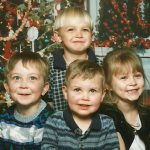 Children, especially young children, don’t really understand what their working parents do every day, and sometimes can even feel abandoned when they are especially young. It’s not their fault. They love their parents, and all children experience some separation anxiety at some point. Once they get used to it, they are fine, of course, but those early days can be tough.
Children, especially young children, don’t really understand what their working parents do every day, and sometimes can even feel abandoned when they are especially young. It’s not their fault. They love their parents, and all children experience some separation anxiety at some point. Once they get used to it, they are fine, of course, but those early days can be tough.
I don’t really know the motivation behind the day they call Take Our Daughters And Sons To Work Day, also called Take Your Child to Work Day. It is a national day that gives children in the United States a brief look at what goes on in the working world…more specifically their parent’s working world. Of course, it’s not always completely authentic, because many of the organizations set up special events for that day. I personally think it would be better to make it as real as possible for the child…if the goal was to show the child what their parent does for a living. The program was developed by the Take Our Daughters And Sons To Work Foundation, which is a non-profit educational organization. As the name depicts, the day revolves around “parents taking their children to work to expose students to future job possibilities and the value of education.” Originally, it was called Take Our Daughters To Work Day, but was expanded to include boys in 2003. I think that originally, the focus was on office jobs, which were considered more for the women, and the jobs men had might have seemed unsafe for children. I suppose that is still the case, but you can’t really discriminate on those jobs either, even if taking a child on a police ride-along might be dangerous.
Take Your Child To Work Day is celebrated in over 200 countries, but in the United States, it takes place on the fourth Thursday in April every year. The most recent Take Our Daughters And Sons To Work Day took place on Thursday, April 23, 2020. I suppose that Covid-19 Pandemic stopped them after that and I don’t know if companies are planning them for this year or not. Take Our Daughters to Work Day originated in New York City in the summer of 1992, started by the “Ms. Foundation for Women” and its president, Marie C. Wilson, the 
 Women’s foundation treasurer, Daren Ball, and with support from foundation founder Gloria Steinem. It really began as a part of the Women’s Liberation movement, I suppose, but today it is very different than it was then. I am definitely not a “women’s libber” kind of girl, so that idea does not appeal to me at all. The first celebration took place on April 22, 1993, and has since been celebrated usually on the fourth Thursday of April in order for the 37 million children, parents, schools in over 3.5 million workplaces across the country, in addition to participants in over 200 countries around the world, to plan ahead for the annual event. The day is generally a school day for most children in the United States, so schools are provided with literature and encouraged to promote the program. Schools are provided with materials for incorporating career exploration into classwork on the day before or after the event. In 2007 the “day” became its own separate foundation, the Take Our Daughters and Sons to Work program was turned over to Carolyn McKecuen, a MacArthur Award recipient, who took effective control as its executive director before relocating to Elizabeth City, North Carolina, where it continues to this day. Gloria Steinem continues to maintain a role with the Take Our Daughters and Sons to Work Foundation as a member of its board of directors.
Women’s foundation treasurer, Daren Ball, and with support from foundation founder Gloria Steinem. It really began as a part of the Women’s Liberation movement, I suppose, but today it is very different than it was then. I am definitely not a “women’s libber” kind of girl, so that idea does not appeal to me at all. The first celebration took place on April 22, 1993, and has since been celebrated usually on the fourth Thursday of April in order for the 37 million children, parents, schools in over 3.5 million workplaces across the country, in addition to participants in over 200 countries around the world, to plan ahead for the annual event. The day is generally a school day for most children in the United States, so schools are provided with literature and encouraged to promote the program. Schools are provided with materials for incorporating career exploration into classwork on the day before or after the event. In 2007 the “day” became its own separate foundation, the Take Our Daughters and Sons to Work program was turned over to Carolyn McKecuen, a MacArthur Award recipient, who took effective control as its executive director before relocating to Elizabeth City, North Carolina, where it continues to this day. Gloria Steinem continues to maintain a role with the Take Our Daughters and Sons to Work Foundation as a member of its board of directors.
The idea is that employees across the United States and around the world get to invite their own children or relatives to join them at work, but the program also encourages employees to invite children from residential programs or shelters who may not be exposed to many adults in skilled professions today. I have never worked in a company that specifically participated in Take Your Child To Work Day, but rather where I worked, at The Stengel Agency, we had an informal option to bring a child in randomly. Mydaughter, Amy Royce and granddaughter, Shai Royce both actually worked with me, and my grandchildren, Chris Petersen, Shai Royce, Caalab Royce, and Josh Petersen have all spent time with me when they couldn’t go to school for whatever 
 reason, including not feeling well. They have slept under my desk, because they wanted to be by Grandma at that time, and my boss, Jim Stengel, being the wonderful man that he was, made allowances for my needs. My co-worker, Carrie Beauchamp brought her daughter, Amanda Ingram to the office, and now she is also an agent in that office, so while we didn’t have a formal program, our children and grandchildren not only spent time in the office, but actually went to work with us in the office. I hope companies continue this program, because I think it is a great program.
reason, including not feeling well. They have slept under my desk, because they wanted to be by Grandma at that time, and my boss, Jim Stengel, being the wonderful man that he was, made allowances for my needs. My co-worker, Carrie Beauchamp brought her daughter, Amanda Ingram to the office, and now she is also an agent in that office, so while we didn’t have a formal program, our children and grandchildren not only spent time in the office, but actually went to work with us in the office. I hope companies continue this program, because I think it is a great program.

 Vasa is a beautiful Swedish warship built between 1626 and 1628. For a warship, the ship was anything but plain. It was a very ornate, which is odd for a warship…at least as we see them today. The ship was built on the orders of the King of Sweden Gustavus Adolphus as part of the military expansion he initiated in a war with Poland-Lithuania, which took place between 1621–1629. Vasa was constructed at the navy yard in Stockholm under a contract with private entrepreneurs in 1626–1627. The ship was armed primarily with bronze cannon cast in Stockholm specifically for the ship. The king had her richly decorated as a symbol of his ambitions for Sweden and for himself. When she was done…she was not only stunningly beautiful, but she was also one of the most powerfully armed vessels in the world. All that was great, but Vasa was also dangerously unstable, with too much weight in the upper structure of the hull. That fact didn’t faze the king, who despite the lack of stability, of which he was informed, ordered Vasa to sea.
Vasa is a beautiful Swedish warship built between 1626 and 1628. For a warship, the ship was anything but plain. It was a very ornate, which is odd for a warship…at least as we see them today. The ship was built on the orders of the King of Sweden Gustavus Adolphus as part of the military expansion he initiated in a war with Poland-Lithuania, which took place between 1621–1629. Vasa was constructed at the navy yard in Stockholm under a contract with private entrepreneurs in 1626–1627. The ship was armed primarily with bronze cannon cast in Stockholm specifically for the ship. The king had her richly decorated as a symbol of his ambitions for Sweden and for himself. When she was done…she was not only stunningly beautiful, but she was also one of the most powerfully armed vessels in the world. All that was great, but Vasa was also dangerously unstable, with too much weight in the upper structure of the hull. That fact didn’t faze the king, who despite the lack of stability, of which he was informed, ordered Vasa to sea.
Vasa’s maiden voyage was an exciting moment for everyone in the area. On August 10, 1628, she set sail from the Stockholm navy yard and after encountering a wind that was barely stronger than a breeze, she sank after sailing roughly 1,400 yards. Seriously, that has to be the shortest maiden voyage on record…for all time. Vasa quickly fell into obscurity after most of her valuable bronze cannon were salvaged in the 17th century, which is odd, because they knew where she was and if they were able to pull the cannon up, why would they not take anything else. Nevertheless, she sat there until she was once again located in the late 1950s in a busy shipping area in Stockholm harbor. Amazingly, the ship was salvaged with a largely intact hull in 1961. She was temporarily housed in a museum called Wasavarvet (“The Vasa Shipyard”) until 1988, when she was moved permanently to the Vasa Museum in the Royal National City Park in Stockholm. Today, the ship is one of Sweden’s most popular tourist attractions. Since her recovery and placement in 1961, over 35 million visitors have seen the ship. Vasa has become a widely recognized symbol of the Swedish Empire…something I’m not sure I would like if I were the king, because while she is beautiful, she is unstable, and what leader would want “a lack of stability” to be part of their nation’s symbol.
It is said that the order to sail was the result of a combination of factors. The king, who was leading the army in Poland at the time of her maiden voyage, was impatient to see her take up her station as flagship of the reserve squadron at Älvsnabben in the Stockholm Archipelago, being the biggest one. Unfortunately, the king’s subordinates lacked the political courage to openly discuss the ship’s problems or to push to have the maiden voyage postponed. Of course, there was an inquiry by the Swedish Privy Council to find out who was responsible for the disaster. Nevertheless, in the end, no one was punished.
When the recovery crew went in to bring Vasa and her contents to the surface once again in 1961, they found thousands of artifacts, among them many items of clothing, weapons, cannon, tools, coins, cutlery, food, drink 
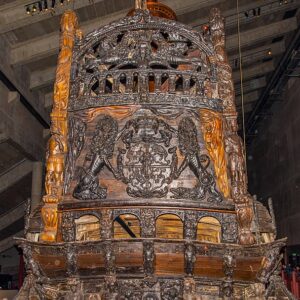 and six of the ten sails. Marine archaeologists also found the remains of at least 15 people in and around Vasa’s hull. The artifacts and the ship herself have provided scholars with invaluable insights into details of naval warfare, shipbuilding techniques, and everyday life in early 17th-century Sweden. Without question, Vasa is the world’s best preserved 17th century ship. The wreck of Vasa continually undergoes monitoring and further research on how to preserve her.
and six of the ten sails. Marine archaeologists also found the remains of at least 15 people in and around Vasa’s hull. The artifacts and the ship herself have provided scholars with invaluable insights into details of naval warfare, shipbuilding techniques, and everyday life in early 17th-century Sweden. Without question, Vasa is the world’s best preserved 17th century ship. The wreck of Vasa continually undergoes monitoring and further research on how to preserve her.
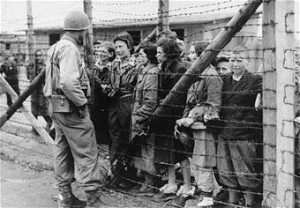 After years of being oppressed, starved, beaten, murdered, and used for experimentation, the Jewish people decided that it was their right to avenge their dead. The Nuremburg Trials were supposed to do all that, but so many of the Nazis had fled the country to escape the sentences they deserved, and once out of the country, it was almost impossible to get them back to face those sentences. In the late 1940s, under Juan Domingo Peron’s leadership (October 17, 1945 to July 1, 1974), the government secretly allowed entry of a number of war criminals fleeing Europe after Nazi Germany’s collapse, as part of the infamous ratlines. The number of Nazi fugitives that fled to Argentina surpassed 300, and included notorious war criminals such as Erich Priebke, Martin Bormann, Joseph Mengele, Eduard Roschmann, Josef Schwammberger, Walter Kutschmann, Otto Skorzeny and Holocaust administrator Adolf Eichmann, among others. In May 1960, Eichmann was kidnapped in Argentina by the Israeli Mossad and brought to trial in Israel. He was executed in 1962. At the time, Argentina condemned the Israeli government for abducting Eichmann, leading to a diplomatic spat between the nations.
After years of being oppressed, starved, beaten, murdered, and used for experimentation, the Jewish people decided that it was their right to avenge their dead. The Nuremburg Trials were supposed to do all that, but so many of the Nazis had fled the country to escape the sentences they deserved, and once out of the country, it was almost impossible to get them back to face those sentences. In the late 1940s, under Juan Domingo Peron’s leadership (October 17, 1945 to July 1, 1974), the government secretly allowed entry of a number of war criminals fleeing Europe after Nazi Germany’s collapse, as part of the infamous ratlines. The number of Nazi fugitives that fled to Argentina surpassed 300, and included notorious war criminals such as Erich Priebke, Martin Bormann, Joseph Mengele, Eduard Roschmann, Josef Schwammberger, Walter Kutschmann, Otto Skorzeny and Holocaust administrator Adolf Eichmann, among others. In May 1960, Eichmann was kidnapped in Argentina by the Israeli Mossad and brought to trial in Israel. He was executed in 1962. At the time, Argentina condemned the Israeli government for abducting Eichmann, leading to a diplomatic spat between the nations.
There was a financial incentive for Argentina to accept these war criminals, and they needed to provide a safe haven for them. Wealthy Germans and Argentine businessmen of German descent were willing to pay the way for escaping Nazis. The initial plan of the fleeing Nazis was to regroup, lay low for a while, and then come back with a vengeance. The Holocaust years had been very profitable for the Nazis. Nazi leaders had plundered untold millions from the Jews they murdered and some of that money accompanied them to Argentina…meaning the Argentine economy was helped by the war criminals…another incentive to help them hide out.
Some of the smarter Nazi officers and collaborators saw the writing on the wall as early as 1943 and began hiding gold, money, valuables, paintings, and more. They often moved their plunder to Switzerland. Ante Pavelic and his cabal of close advisors had several chests full of gold, jewelry, and art they had stolen from their Jewish and Serbian victims. These riches eased their passage to Argentina considerably. Disappearing, even in 1945 was not an easy matter, but if one had money, it was far more possible. The war criminals even paid off British officers to let them through Allied lines…a treasonous act for which those British officers should have 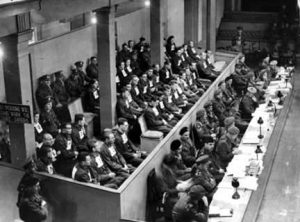 also been prosecuted and hung. Sometimes the corruption in government and military entities, even those who are supposed to be on the side of good, is absolutely astounding.
also been prosecuted and hung. Sometimes the corruption in government and military entities, even those who are supposed to be on the side of good, is absolutely astounding.
After the World War II, and the release of the surviving Jews, the Nuremburg Trials convicted these evil monsters, but many of them were gone before their sentence could be carried out. Enter the Nokmim, a group of Jewish men, also referred to as The Avengers or the Jewish Avengers. These men were a Jewish partisan militia, formed by Abba Kovner and his lieutenants Vitka Kempner and Rozka Korczak from the surviving remnants of the United Partisan Organization (Fareynikte Partizaner Organizatsye), which operated in Lithuania under Soviet command. Elements of the Nokmim collaborated with veterans of the Jewish brigade in British Palestine to form a new organization called Nakam, a group of assassins that targeted Nazi war criminals with the aim of avenging the Holocaust. The name comes from the phrase (Dam Yehudi Nakam – “Jewish Blood Will Be Avenged”) (the acronym DIN means “judgement”).
The Nakam (“vengeance”) Group was the most extremist group. They numbered around 60 Jews who were former Partisans, as well as other Jews who survived the Holocaust. This group was not about to let these men get away with all the atrocities they put their Jewish captives through, and then just walk away without punishment…not if they could help it. The group arrived in Germany after the war in order to conduct more complicated and fatal vengeance operations. Their ultimate purpose was to carry out an operation that would cause a broad international response…a warning, if you will, to anyone who might consider trying to harm Jews again, as the Nazis had. They needed to show the world that they would never be treated in such a way again. They would fight back…every time. Notables among the Hanakam group were Abba Kovner, Yitzhak Avidav, and Bezalel Michaeli. The group attempted a couple of mass poisonings, the first of the water supplies of Munich, Berlin, Weimar, Nuremberg and Hamburg, which failed when the poison had to be thrown overboard on a ship when Kovner was discovered to be carrying forges documents. The other attempt was with 3,000 loaves of bread painted with diluted arsenic, headed for 15,000 German POWs from the Langwasser internment camp near Nuremberg. The camp was under US authority. On April 23, 1946, it was reported that 2,283 German prisoners of war had fallen ill from poisoning, with 207 hospitalized and seriously ill. According to Harmatz, 300 to 400 Germans died. He said this “was nothing compared with what we really wanted to do.” A 2016 report by the Associated Press countered that the operation ultimately caused no known deaths, despite documents obtained through a Freedom of Information Act request to the National Archives and Records Administration 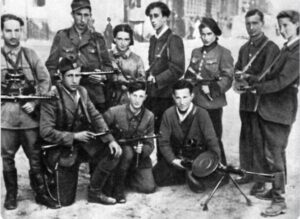 stating the arsenic found in the bakery was enough to kill approximately 60,000 persons. Apparently, the arsenic was spread too thin to be lethal.
stating the arsenic found in the bakery was enough to kill approximately 60,000 persons. Apparently, the arsenic was spread too thin to be lethal.
It’s hard to say just how much information is correct and how much is incorrect. I suppose it depends on who is reporting, and how accurately they want to report what they have. Propaganda in any war runs rampant, so we will likely never know. Records can and do go missing, especially when someone wants to disprove their enemies. Whether so many people died by poisoning or not, the Nokmim and the spin-off Nakam brought vengeance on many of the Nazis who would have escaped justice without them.
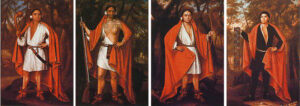 The New World (later the United States of America) was a pretty rough place in 1710. Great Britain owned a small portion of the whole of the New World, and the rest was often vied for against the French and other nations. That year, the mayor of Albany, New York, Pieter Schuyler, arranged a meeting between Queen Anne and five Indian Kings who wanted to request her aid, militarily. The Four Indian Kings or Four Kings of the New World were three Mohawk chiefs from one of the Five Nations of the Iroquois Confederacy and a Mahican of the Algonquian peoples. Five chiefs set out on the journey, but one died in mid-Atlantic. The three Mohawk Kings were Sa Ga Yeath Qua Pieth Tow of the Bear Clan, called King of Maquas, with the Christian name Peter Brant (grandfather of Mohawk leader Joseph Brant); Ho Nee Yeath Taw No Row of the Wolf Clan, called King of Canajoharie (“Great Boiling Pot”), or John of Canajoharie; and Tee Yee Ho Ga Row, meaning “Double Life”, of the Wolf Clan, also called Hendrick Tejonihokarawa or King Hendrick. The Mahican chief was Etow Oh Koam of the Turtle Clan, mistakenly identified in his portrait as Emperor of the Six Nations. The Algonquian-speaking Mahican people were not part of the Iroquois Confederacy.
The New World (later the United States of America) was a pretty rough place in 1710. Great Britain owned a small portion of the whole of the New World, and the rest was often vied for against the French and other nations. That year, the mayor of Albany, New York, Pieter Schuyler, arranged a meeting between Queen Anne and five Indian Kings who wanted to request her aid, militarily. The Four Indian Kings or Four Kings of the New World were three Mohawk chiefs from one of the Five Nations of the Iroquois Confederacy and a Mahican of the Algonquian peoples. Five chiefs set out on the journey, but one died in mid-Atlantic. The three Mohawk Kings were Sa Ga Yeath Qua Pieth Tow of the Bear Clan, called King of Maquas, with the Christian name Peter Brant (grandfather of Mohawk leader Joseph Brant); Ho Nee Yeath Taw No Row of the Wolf Clan, called King of Canajoharie (“Great Boiling Pot”), or John of Canajoharie; and Tee Yee Ho Ga Row, meaning “Double Life”, of the Wolf Clan, also called Hendrick Tejonihokarawa or King Hendrick. The Mahican chief was Etow Oh Koam of the Turtle Clan, mistakenly identified in his portrait as Emperor of the Six Nations. The Algonquian-speaking Mahican people were not part of the Iroquois Confederacy.
When the kings arrived in London, they were treated like diplomats. They were transported through the streets of the city in Royal carriages and received by Queen Anne at the Court of Saint James Palace. They visited the Tower of London and Saint Paul’s Cathedral as well, and they got to tour and do things all over London to honor their visit. They watched a review of the Guards in Hyde Park, visited the Banqueting House and Chapel at Whitehall, and they were taken on the Queen’s barge to Greenwich Hospital and the Woolwich Arsenal, where they heard a saluting cannonade. They listened to sermons in the city’s churches. They were guests of 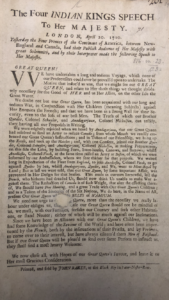 honor at a dinner hosted by the Board of Trade and were privately entertained by William Penn at the Taverne du Diable at Charing Cross. They attended a performance of Powell’s Marionettes at Punch’s Theater; a presentation of Macbeth where they got to sit on the stage. I’m sure the people of the city were quite curious about these “wild men” who had come to their city. Their clothing was so different from the sophisticated garb that was normally seen gracing the royal carriages. Still, the Indians were probably wearing their finest clothing too, and in the New World, it was probably top of the line. The queen wanted to commemorate the diplomatic visit, so the Crown commissioned Jan Verelst to paint the portraits of the Four Kings. These paintings hung in Kensington Palace until 1977, when Queen Elizabeth II had them relocated to the National Archives of Canada. She unveiled them in Ottawa.
honor at a dinner hosted by the Board of Trade and were privately entertained by William Penn at the Taverne du Diable at Charing Cross. They attended a performance of Powell’s Marionettes at Punch’s Theater; a presentation of Macbeth where they got to sit on the stage. I’m sure the people of the city were quite curious about these “wild men” who had come to their city. Their clothing was so different from the sophisticated garb that was normally seen gracing the royal carriages. Still, the Indians were probably wearing their finest clothing too, and in the New World, it was probably top of the line. The queen wanted to commemorate the diplomatic visit, so the Crown commissioned Jan Verelst to paint the portraits of the Four Kings. These paintings hung in Kensington Palace until 1977, when Queen Elizabeth II had them relocated to the National Archives of Canada. She unveiled them in Ottawa.
The four kings were quite a spectacle in London, they were all described in a contemporary pamphlet as being in shape, muscular and within an inch or two of being six feet tall. Their complexions were described as being brown and their hair long and black.” Their visages are very awful and majestick, and their features regular enough, though something of the austere and sullen.” Their faces are covered in art, probably meant to inspire terror during battle. They are described as polite, they will not refuse any drink or food that is offered to them. They loved English beef more than any other kind of food offered to them. The people of London also described them as healthy. “Their health is good, as is proper for primitives; they know no gout, dropsy, gravel, or fevers.”
While I’m sure the big city was awe inspiring for the Kings, they were really there on a mission…to requesting military aid for defense against the French, and the chiefs to ask for missionaries to offset the influence of French Jesuits, who had converted numerous Mohawk to Catholicism. When they met with Queen Anne the court was mourning for the death of the Prince of Denmark, so the four Indian Kings were dressed in all black attire when they met with her. Their address to her was read, they asked for military assistance and missionaries to lead them to “true religion.” After the reading, the chiefs presented the queen with several belts of wampum to signify their meeting. In return for the gifts of the wampum, the queen gave them a set of communion plates, with the royal cipher and coat of arms, for a future Mohawk chapel. (These are now divided between the Mohawk reservations at Brantford, Ontario, and Tyendinaga, near Kingston.) The Archbishop of Canterbury gave each of the chiefs a Bible bound in Turkey-red leather. When she heard their request, Queen Anne informed the Archbishop of Canterbury, Thomas Tenison. They authorized a mission, and Mayor Schuyler  had a chapel built the next year at Fort Hunter (located near the Mohawk “Lower Castle” village) along the Mohawk River. The queen also engaged the four men in conversation through their interpreter, Peter Schuyler’s brother, John. Queen Anne was very generous to the Kings and their people, sending a gift of a silver Communion set and a reed organ. The Mohawk village known as the “Lower Castle” became mostly Christianized village in the early 18th century, unlike the “Upper Castle” at Canajoharie further upriver, where there was no mission founded until 1769, when William Johnson, British agent to the Iroquois, built the Indian Castle Church, which still stands today.
had a chapel built the next year at Fort Hunter (located near the Mohawk “Lower Castle” village) along the Mohawk River. The queen also engaged the four men in conversation through their interpreter, Peter Schuyler’s brother, John. Queen Anne was very generous to the Kings and their people, sending a gift of a silver Communion set and a reed organ. The Mohawk village known as the “Lower Castle” became mostly Christianized village in the early 18th century, unlike the “Upper Castle” at Canajoharie further upriver, where there was no mission founded until 1769, when William Johnson, British agent to the Iroquois, built the Indian Castle Church, which still stands today.
During their visit to London, the Kings were lodged at The Crown and Cushion, in King Street, Covent Garden. Here they slept on beds for the first time and became accustomed to them. Thomas Arne was their host, he was an inn keep and an upholsterer, he was very kind and considerate to his visitors. Because of this, the Indians renamed him Cataraqui in a Mohawk christening ceremony. Cataraqui was the fort that has now become the city of Kingston, Ontario. I’m sure that they really missed those beds when they returned to the New World in May of 1710.
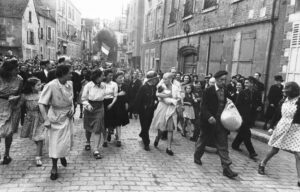 Having a baby is normally a blessed event, but it is also important to be having the baby with the right person. I know that sound like something that is between the man and the woman, and it’s nobody’s business but their own, and I would agree with you on that. However, during World War II, the Nazi regime was so hated that the nations they terrorized didn’t want anything to do with them…so much so that French women having babies with German soldiers were punished by shaving their heads bald and parading them through town. This was done so that everyone would know they betrayed their country, and so they had.
Having a baby is normally a blessed event, but it is also important to be having the baby with the right person. I know that sound like something that is between the man and the woman, and it’s nobody’s business but their own, and I would agree with you on that. However, during World War II, the Nazi regime was so hated that the nations they terrorized didn’t want anything to do with them…so much so that French women having babies with German soldiers were punished by shaving their heads bald and parading them through town. This was done so that everyone would know they betrayed their country, and so they had.
The Nazi regime was set on creating “the perfect race,” in their opinion anyway. They wanted everyone to be light skinned, blond haired, and blue eyed, and those who weren’t had to prove their genetic lines. The Nazis even went so far as to set up places that women (of the right bloodlines) were sent to have their children, conceived with German soldiers. Then, the plan was that they would give their children up for adoption by a Nazi couple who was having trouble conceiving. It was Hitler’s way of preserving the “right” bloodline. Many times, if the woman changed her mind, and wanted to keep the baby, but refused to marry the soldier, their babies were taken from the by force, even if it meant taking their lives. Some of these 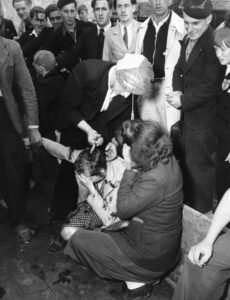 women were in it for the money and had no intention of keeping their babies. They were a simply a “Nazi Baby Machine.”
women were in it for the money and had no intention of keeping their babies. They were a simply a “Nazi Baby Machine.”
Once it was discovered that these women were doing this, they were marked as traitors. Often their own families disowned them. These women might not even be having babies with the Nazi soldiers, just having relations with them. The soldiers saw nothing wrong with hooking up with these women to ply them for information. It was an act of treason on the part of the women. They shouldn’t have allowed themselves to become involved with the Nazi soldiers, because they just had to know that was wrong. Treason is such a dark side of war. Still, there are many dark sides to war, and in most cases, it is the innocent and oppressed that suffer.
The French resistance brought out another dark side to the war, and it was rather brutal, but they felt like it was justified. Looking at it now, I think the beating part was the probably brutal, but maybe still have been justified. Basically, the French Resistance, when women were caught in a physical relationship with a Nazi, shaved their heads, beat the women who had been charged with collaborating with the enemy, and then paraded them around town as a form of punishment. The punishment was followed by harassing the women, with no repercussion for the beatings, head shavings, or the harassing. In France, a woman’s long hair is supposed to be seductive, so shaving their heads, was a way to make them look undesirable. The practice dates back to Biblical times. It was a common punishment for adultery. During the 20th century, it was reintroduced as a means to ridicule women who had physical relationships with the enemy or were prostitutes. 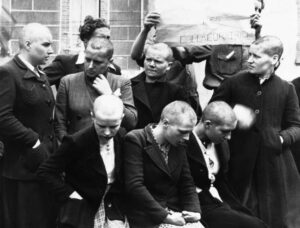 The French Resistance took a page from Bible times, and so it came to pass that during World War II, this act of humiliation was repeated on French women accused of collaborating with the German soldiers. Apart from shaving their heads, they were paraded in the streets, marked with black ink, and even stripped half-naked. At least 20,000 women have been documented to have had their heads shaved. I’m not a proponent of violence, but traitors need to be punished, and after something like that, I would think these women would think twice before getting involved with the Nazi soldiers. and any woman who hadn’t done so, would think twice before even considering such a heinous act.
The French Resistance took a page from Bible times, and so it came to pass that during World War II, this act of humiliation was repeated on French women accused of collaborating with the German soldiers. Apart from shaving their heads, they were paraded in the streets, marked with black ink, and even stripped half-naked. At least 20,000 women have been documented to have had their heads shaved. I’m not a proponent of violence, but traitors need to be punished, and after something like that, I would think these women would think twice before getting involved with the Nazi soldiers. and any woman who hadn’t done so, would think twice before even considering such a heinous act.

